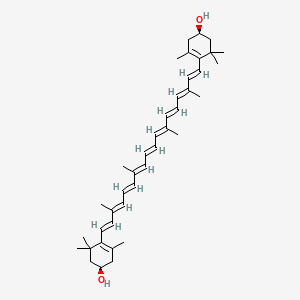| Baroli I and Niyogi KK |
Molecular genetics of xanthophyll-dependent photoprotection in green algae and plants. |
2000 |
Philos. Trans. R. Soc. Lond., B, Biol. Sci. |
pmid:11127993
|
| Pogson BJ and Rissler HM |
Genetic manipulation of carotenoid biosynthesis and photoprotection. |
2000 |
Philos. Trans. R. Soc. Lond., B, Biol. Sci. |
pmid:11127994
|
| Bone RA et al. |
Macular pigment in donor eyes with and without AMD: a case-control study. |
2001 |
Invest. Ophthalmol. Vis. Sci. |
pmid:11133874
|
| Beatty S et al. |
Macular pigment and risk for age-related macular degeneration in subjects from a Northern European population. |
2001 |
Invest. Ophthalmol. Vis. Sci. |
pmid:11157880
|
| Leung I et al. |
Absorption and tissue distribution of zeaxanthin and lutein in rhesus monkeys after taking Fructus lycii (Gou Qi Zi) extract. |
2001 |
Invest. Ophthalmol. Vis. Sci. |
pmid:11157884
|
| Crimi M et al. |
Time-resolved fluorescence analysis of the recombinant photosystem II antenna complex CP29. Effects of zeaxanthin, pH and phosphorylation. |
2001 |
Eur. J. Biochem. |
pmid:11168359
|
| Frank HA et al. |
Photochemical behavior of xanthophylls in the recombinant photosystem II antenna complex, CP26. |
2001 |
Biochemistry |
pmid:11170447
|
| Jin X et al. |
The hypocotyl chloroplast plays a role in phototropic bending of Arabidopsis seedlings: developmental and genetic evidence. |
2001 |
J. Exp. Bot. |
pmid:11181717
|
| Breithaupt DE |
Enzymatic hydrolysis of carotenoid fatty acid esters of red pepper (Capsicum annuum L.) by a lipase from Candida rugosa. |
2000 Nov-Dec |
Z. Naturforsch., C, J. Biosci. |
pmid:11204204
|
| Wei W et al. |
Association of smoking with serum and dietary levels of antioxidants in adults: NHANES III, 1988-1994. |
2001 |
Am J Public Health |
pmid:11211635
|
| Mares-Perlman JA et al. |
Lutein and zeaxanthin in the diet and serum and their relation to age-related maculopathy in the third national health and nutrition examination survey. |
2001 |
Am. J. Epidemiol. |
pmid:11226974
|
| Bertone ER et al. |
A population-based case-control study of carotenoid and vitamin A intake and ovarian cancer (United States). |
2001 |
Cancer Causes Control |
pmid:11227928
|
| Nishino H et al. |
Cancer prevention by natural carotenoids. |
2000 |
Biofactors |
pmid:11237205
|
| Pérez-Vendrell AM et al. |
Influence of source and ratio of xanthophyll pigments on broiler chicken pigmentation and performance. |
2001 |
Poult. Sci. |
pmid:11261563
|
| Lutnaes BF et al. |
Is (9Z)-"meso"-zeaxanthin optically active? |
2001 |
Chirality |
pmid:11284028
|
| Lohr M and Wilhelm C |
Xanthophyll synthesis in diatoms: quantification of putative intermediates and comparison of pigment conversion kinetics with rate constants derived from a model. |
2001 |
Planta |
pmid:11289603
|
| Ciulla TA et al. |
Macular pigment optical density in a midwestern sample. |
2001 |
Ophthalmology |
pmid:11297490
|
| Ruban AV et al. |
Configuration and dynamics of xanthophylls in light-harvesting antennae of higher plants. Spectroscopic analysis of isolated light-harvesting complex of photosystem II and thylakoid membranes. |
2001 |
J. Biol. Chem. |
pmid:11331293
|
| Bukhov NG et al. |
A few molecules of zeaxanthin per reaction centre of photosystem II permit effective thermal dissipation of light energy in photosystem II of a poikilohydric moss. |
2001 |
Planta |
pmid:11346947
|
| Bukhov NG et al. |
Energy dissipation in photosynthesis: does the quenching of chlorophyll fluorescence originate from antenna complexes of photosystem II or from the reaction center? |
2001 |
Planta |
pmid:11346948
|
